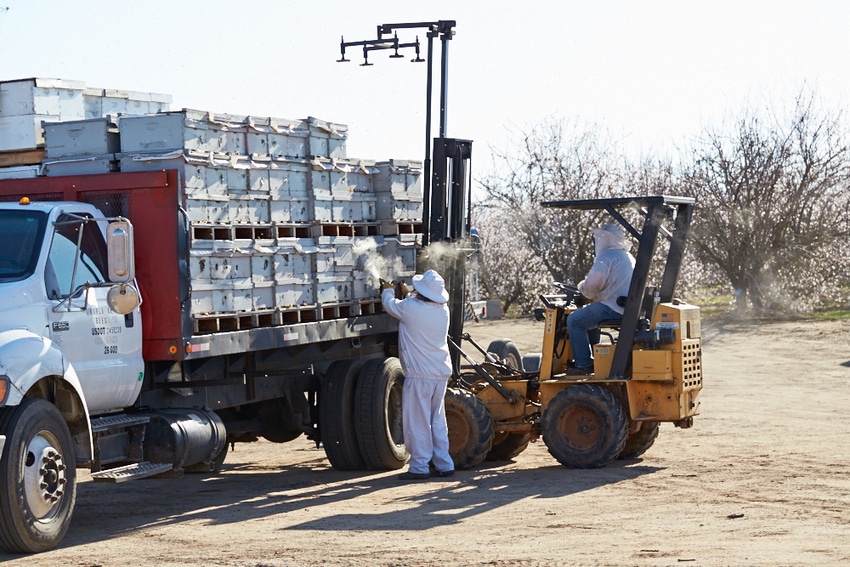February 3, 2015

Some 1.7 million beehives have moved into California’s 860,000 acres of almonds across the Central Valley to pollinate the state’s almond crop.
The importance of bees to the success of California Almonds is undeniable. What may be less understood is the amount of money, time and manpower beekeepers invest to get these bees healthy and ready to pollinate the crop.
Beekeepers report that inputs are growing steadily each year, as rising demand and pressures on honey bee health challenge them to produce more and more healthy hives.
Ryan Cosyns, whose family has been farming almonds in Madera County since the early 1970s has raised bees for his own operation and outside growers for the past eight years. He says beekeepers continue to deal with a number of issues that includes working to meet rising demand for honey bees in almonds while constantly rebuilding hives to deal with overwintering hive losses of 30 percent or more.
Losses to Varroa mites and lack of native forage top the list of challenges beekeepers face, forcing them to increase inputs for mite control and supplemental feed to reduce pressures and subsequent overwintering losses to their bee populations.
“The only way we will have good hives for almonds is if we keep our mite counts down and make sure we will have a fall protein source,” said Jackie Park-Burris, a second-generation queen producer and commercial beekeeper in Palo Cedro, near Redding, Calif. Her company, Jackie Park-Burris Queens, provides 1,200 hives to almond growers and produces queens for beekeepers around the U.S. and Canada.
“Managing the Varroa mite has changed the way we bee-keep,” Park-Burris continued, noting it is her biggest and most constant challenge.
“Being a queen producer, I make absolutely sure I have my mites dead by November,” she said. “I treat, I check, and I recheck and re-treat as necessary.”
Park-Burris estimates mite management has increased the amount of time she spends with the hives by 40 percent, which translates into increased labor, fuel and other costs. Each queen she produces requires 15 drones, and mite treatments applied at the wrong time can make drones sterile, she said, leaving a constrained window for effective control.
Varroa Mite
John Miller is a fourth-generation beekeeper who splits his time between California and North Dakota to annually run 12,000 hives into almonds. He doesn’t complain, but points out these are unprecedented times for beekeepers.
“The last 30 years have been the most tumultuous time for beekeepers in almost four centuries,” he said. “In the 1980s we had tracheal mites, and we solved that problem. Now it’s Varroa, Varroa, Varroa and everything else.”
Rising corn and soybean prices created an incentive to farm land in the Upper Plains that had been taken out of production for years — land that was often excellent pollinator habitat during the summer.
Acreage once left native as part of the USDA’s Conservation Reserve Program has been converted to corn and soybean production. This loss of native forage, and a general loss of bee pasture and wildflowers due to drought and other factors, is forcing beekeepers to increase the level of supplemental protein and sugar feed they provide their colonies. Forage losses have also greatly diminished the honey revenue side for professional beekeepers.
Park-Burris has increased the supplemental pollen she feeds her bees by 10-fold in the last five years.
Miller also said the costs for supplemental feeding have exploded in the last decade. Last year, he fed 1.2 million pounds of supplemental feed, including 800,000 pounds to get hives ready for pollination and another 400,000 or so to prepare them for winter.
“In the U.S., beekeepers now feed more calories to their hives than they harvest from their hives in honey. This has never happened before,” Miller explained.
He added that hive theft is also becoming a more common concern for professional beekeepers. He relies on the eyes and ears of his almond-growing customers for theft prevention, but losses are inevitable.
Rebuilding colonies
Cosyns Farms Bee Co. each year splits and divides hives and sends them to North Dakota for the summer to rebuild. Once thee bees awaken, Ryan Cosyns typically feeds each hive about six pounds of supplemental pollen patties at $1.25 per pound.
He also treats for mites two or three times a year, and regularly tests and treats for a harmful bacteria that grows in the digestive tract of honey bees. Chemical exposures can also pose a risk, Cosyns said.
In general, beekeepers say that they and almond growers have the same interest: producing and maintaining healthy bee colonies to optimize pollination.
“It’s a relationship that’s built on trust,” Miller stated.
Beekeepers say that communication between partnering growers and beekeepers is critical.
When orchard management problems such as tank-mixing insecticides led to concerns about bee losses they agree that almond growers almost universally responded to beekeepers’ concerns by changing practices and avoiding tank mixes that include insecticides. Growers also agreed that fungicide sprays, only when necessary, would be done late in the afternoon or evening when the bees were done for the day.
“Last year, we started having meetings between beekeepers, almond growers, the Department of Pesticide Regulation, the Almond Board and Project Apis m., and working to educate growers,” Park-Burris said. “The industry has responded, and now growers are timing those applications to avoid bees. My growers always bend over backward to accommodate the health of my bees.”
In turn, beekeepers make robust efforts every year to meet rising demand for healthy hives for almond pollination.
As part of an ongoing commitment to honey bee health, the Almond Board of California recently released a comprehensive set of honey bee best management practices (BMPs) for California’s almond industry. Bee BMP guides are available at Almond Board offices and events, and also online at www.almonds.com/BeeBMPs.
You May Also Like




